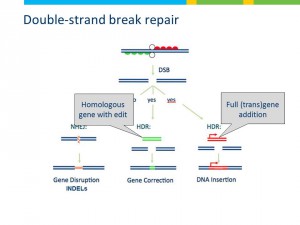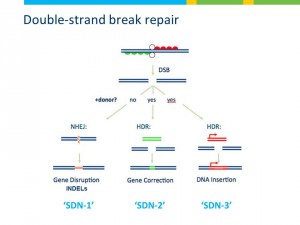Nuclease a Gyfarwyddir ar y Safle (SDN) Mae golygu genom yn golygu defnyddio gwahanol ensymau torri DNA (cnewyllyn) sy'n cael eu cyfeirio i dorri'r DNA mewn lleoliad a bennwyd ymlaen llaw gan ystod o wahanol systemau rhwymo DNA. Ar ôl i'r toriad gael ei wneud, mae mecanwaith atgyweirio DNA y gell ei hun yn cydnabod y toriad ac yn atgyweirio'r difrod, defnyddio un o ddau lwybr sy'n bresennol yn naturiol mewn celloedd:
- diwedd-uno anhomolog (NHEJ): Mae'r DNA wedi'i dorri yn cael ei ailymuno, ond wrth wneud hyn efallai y bydd ychydig o barau bas yn cael eu bwyta i ffwrdd neu eu hychwanegu gan arwain at ddileu mân ar hap (hyd at 20) neu ychwanegiadau (ychydig o barau sylfaen) niwcleotidau yn y safle torri.
- atgyweirio dan gyfarwyddyd homoleg (HDR): defnyddir DNA rhoddwr sy'n cario'r newid a ddymunir ac sydd â homoleg â'r safle targed i gyflwyno'r newid hwn yn y safle torri. Yn y modd hwn gallwch chi gyflwyno mewnosodiadau bwriadol penodol, newid neu ddileu.


Mae golygu genom yn caniatáu i nodwedd annymunol neu'r (ath)cyflwyno nodwedd ddymunol.
Mae technegau golygu genom cyfryngol niwcleas yn cynnwys:
